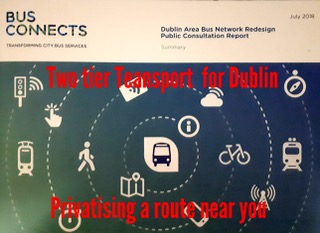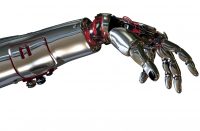There is no doubt that, with our ever-expanding capital city, public transport needs to be continually expanded and improved to meet the ever changing requirements of a modern city. Typical of our gombeen political class instead of improving and expanding the bus service continuously, the system is neglected, under funded and allowed to become overloaded and stretched to its limits before anything is done. Then, when crisis point is reached, consultants are flown in to sort the mess out.
“ Bus Connect” is a new public transport plan designed by American based “transport expert” Jarrett Walker. Dublin bus management, staff and trade unions have built up the expertise and a huge range of knowledge on what is required for the people and transport in Dublin — being at the coal face of public transport for decades. As Mark Twain said “ an expert is just a guy from out of town” it’s quite ironic that the man with the plan is called Walker, as the changes will involve a lot of walking for many of our citizens.
The proposed new bus system is a total change from the way public transport operates in Dublin at the moment. The new plan is centred around seven very high frequency bus spines named A to G running across the city. The main spines are very high frequency of three to four minutes which start approximately five miles from the city centre. For example, spine A runs between Whitehall on the north side to Rathgar on the south. The spines are continued on in both directions by less frequent branches every 10 to 15 minutes and will be numbered A1, A2, A3 and A4 etc. feeding the main spines from Swords and the airport on the north side to Tallaght and Dundrum on the south side, in the case of spine A.
The branches in turn will be fed by new local routes and orbital routes will link the spines to each other — these will vary in frequency from 10 to 40 minutes. For people living on the main spine, close to the city centre, this new system will offer improvements. However, there are huge discrepancies in the frequency of the branches, for example, Main Street Swords is served by the A4 spine — which between 7:00 and 8:00, morning rush hour, has a frequency of one bus every 10 minutes direct to the city. Previously Swords Main Street was served by the 41, 41b, 41c, 43 and the 33 between these times; a total of 19 buses went down the main street on their way to the city. If we use the Bus Connect method of frequency (that is departures from Terminus) this would be a frequency of one bus every three minutes directly into the city centre. This system is supposed to be much easier and simpler to understand but it appears quite complicated and unclear as to the real frequency or improvements, if any, to the service — even if you live close to a branch.
For the people further out in estates and areas not served by a branch the service is even worse. Once you are away from a branch you are faced with either up to three bus changes per journey and or a long walk to a branch. Many people living in housing estates or outlying suburbs such as Balbriggan, Skerries etc. the new system will be a massive reduction to the existing services with an end to all direct routes into the city centre. The trip to the city centre will be more complicated, will take longer with numerous bus changes and/or long walks to get to your destination.
This is a two-tier public transport system where some citizens in more affluent areas will have an excellent service but others who have been forced to live further out from the city by unaffordable accommodation costs will be abandoned in their housing estates with long walks or an infrequent local bus service.
This plan has privatisation written all over it — numerous new orbital routes have been created. These are the very type of routes that have been privatised and taken from the Dublin bus operations. This sets a dangerous precedent for orbital routes. The very high frequency spines will be very lucrative and, as in the case of Bus Éireann, the most lucrative direct express routes are cherry picked by the private operators. In all likelihood Dublin bus will be left operating infrequent routes in and out of housing estates and far flung suburbs around the City. It is also very strange that the A spine is not extended out to at least Swords via the airport tunnel as this is the quickest route into the city at peak times but the existing private route “Swords express” seems to have a monopoly on this tunnel — apart from a couple of early morning buses to UCD.
The privatisation of the orbital bus routes now operated by Go Ahead Bus has been used as a vehicle to introduce lower pay and poorer working conditions for the staff on these routes. This new plan will be used as a further means to introduce poverty wages and poor working conditions in the guise of improving transport services. This cannot and will not be allowed to happen by transport workers who have successfully led the way in fighting back against austerity cuts and pay stagnation in recent times.
A sectoral employment agreement must be put in place for all transport workers to protect terms and conditions and remove wages from the equation when new routes are tendered for.
The increase in frequency on some routes is to be welcomed — as is the expansion of destinations linked to each other. The one fare per journey idea is the way to go, but it needs to be much cheaper than fares at present, which are not encouraging people out of their cars. Priority for buses over cars is essential to get people to encourage people onto public transport.
It is unacceptable for services to be cut, stopped or have frequency reduced even if others are improved. There is no room for a two tier transport system for the citizens of Dublin. It is the people that live furthest out from the city centre that have to be encouraged out of their cars and onto public transport if congestion is to be dealt with in any meaningful way. This will be done by increasing frequency, reducing journey times and fares. Many people living close to the city have abandoned their cars long ago as it is often quicker to walk or cycle into town.
If the NTA had utilised the expertise that already existed in Dublin bus to design network changes, this type of situation would be well known — because there is nobody who knows the customers requirements better than those that have been fulfilling the transport needs of the citizens of Dublin for generations. That is Dublin bus management, staff and trade unions. Dublin Bus must be congratulated for the service that they provide despite the gross underfunding of the system. State subvention to public transport has been cut by 41 per cent since 2008, this funding needs to be returned to its peak levels along with increases allowing for inflation. During the austerity years huge debts were run up by the CIE companies due to cuts and underfunding, this burden is unsustainable — a one-off payment is required to deal with this situation. Decent public transport requires sufficient public funding in order for it to operate properly.
There is an urgent need to set up a forum between the NTA, Dublin bus, the trade unions and the Department of Transport where a plan worthy of the citizens of our capital city can be designed — to the benefit of everyone not just those who happen to be living on a spine.
The “bus connect” plan does quite the opposite, it disconnects communities and passengers into a two tier system instead of providing regular, rapid, efficient, comfortable, environmentally friendly and cheap transport to all the destinations necessary for our city to function.
The plan is up for a public consultation over the summer it is essential that citizens have their say about this plan to disconnect and bisect the public transport system. Details are available along with an on-line survey on the web site: busconnect.ie.






